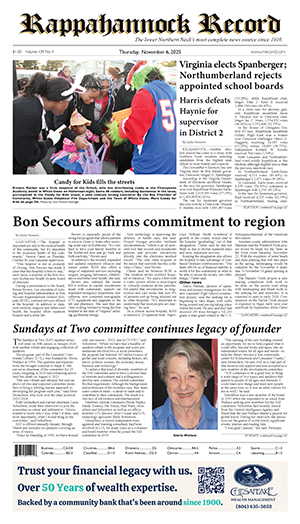The recent public meeting concerning plans for a replacement for the Robert O. Norris Jr. Memorial Bridge brings back memories of the rehabilitation of the bridge over 30 years ago.
At that time VDOT decided to resurface the bridge and announced that the process would take approximately three years, with the bridge being closed to traffic for 10 hours per night. That announcement led to a massive uproar from citizens in the Northern Neck and Middlesex County.
The opposition to the closing of the bridge was spearheaded by the late Betty Barrack, then a member of the Lancaster County Board of Supervisors. Betty was determined that the bridge had to remain open 24/7. She began putting together a committee of concerned citizens to lobby to that end. As I was serving on the Northumberland County Board of Supervisors, my colleagues designated me to be their representative on the committee. That was in the summer of 1993. VDOT agreed to recognize the committee, thereby beginning almost three years of monthly meetings in concert with VDOT officials.
The bridge had opened in 1957, replacing the ferries that ran from White Stone to Greys Point, parallel to the site for the new bridge. Originally, the ferries ran from Urbanna to Irvington until the route was changed to shorten the time in transit. For many locals and visitors alike, the bridge has been known as the “scary bridge,” some folks refusing to drive across it. In attempt to allay those fears, VDOT announced that the rehabilitation would widen the pavement by one foot, six inches in each lane.
Our committee scheduled a community meeting for Middlesex High School to afford people an opportunity to express their concerns about the nightly closures. Over 300 people attended. Our opposition had impressed VDOT with the need to come to the meeting and address the issue. The late Ray Pethtel, then serving as Commonwealth Commissioner of Transportation, realized that he needed to be present to handle the citizens’ outrage at the planned nightly closure.
During the meeting, one lady rose and asked how the closure would affect expectant mothers living south of the Rappahannock and planning to deliver their babies at Rappahannock General Hospital. The Commissioner responded with the memorable words, “Madam, you don’t understand the progress modern medicine has made. Today, the doctor merely assigns a date for the delivery, and mothers south of the river simply need to tell their doctors that they want to deliver during the daytime.”
His remark prompted Dr. James Hamilton, an obstetrician at R.G.H., to stand and say, “I’ve delivered hundreds of babies, and I never could predict the exact time the baby would be coming.” Undaunted, Pethtel replied, “Oh, I guess I might be mistaken.” That exchange proved to be the turning point in VDOT’s plans. Shortly thereafter, the VDOT spokesman announced that the bridge would remain open for one-way traffic 24/7.
A hump system was developed whereby progressively, a temporary hump allowed traffic to proceed section-by-section. As the process was drawing to a close, our committee met in October 1995 to plan a dedication ceremony for the rehabilitation. We set the date for January 5, 1996.
In those days, my Good Wife and I were expecting the arrival of the second B.E. on December 28. I came home from the meeting and told her that the B.E. would arrive on the morning of January 5. She asked why, and I said that after three years of perfect attendance at the bridge committee meetings, I knew I would miss the rededication—my hunch proved to be accurate.
Citizens often think of themselves as being helpless in the face of governmental bureaucracy, pawns in the greater scene, incapable of affecting significant change. In the case of the Norris Bridge rehabilitation, such proved not to be the case.






